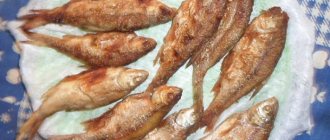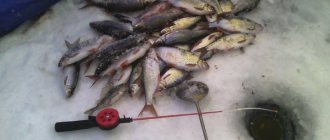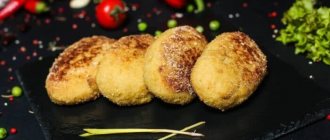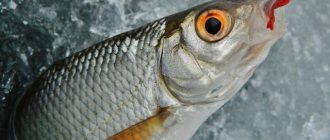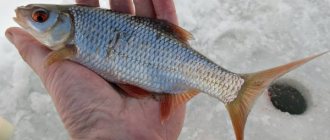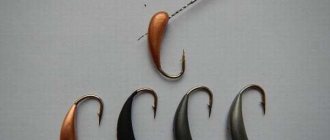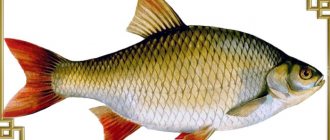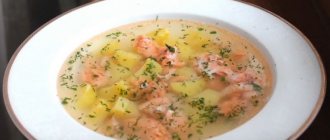Salting ides for drying
Before drying the ide, we inspect the catch. We select medium specimens approximately 20-25 centimeters long for drying. It is better if all the fish are the same size, so it will be salted evenly and will dry at the same time. For pickling, take a batch of ides of 15-20 pieces at once. In addition, we will need:
- Coarse rock salt - 3 kilograms,
- bay leaf - 6-8 leaves,
- wooden box with holes in the bottom,
- polyethylene film,
- heavy oppression,
- wire hooks - according to the number of carcasses.
- Number of servings: 15-20 pieces;
- Preparation time: 3 weeks.
To begin with, the selected fish must be washed and, if desired, gutted. There is no need to gut small ides, but it is better to remove the insides of medium and large carcasses so as not to spoil the finished product. Place a layer of salt at the bottom of the box, a couple of fingers thick. We rub the inside of each ide well with salt - it should gradually be absorbed into the fish and not only add taste, but also disinfect it from parasites. At the same time, salt will draw moisture out of the meat, which will have a good effect on drying.
We place the ide head to tail at the bottom of the box on a layer of salt. Sprinkle salt evenly over the top again. If all the fish doesn’t fit in one layer, it doesn’t matter. Make another layer on top and sprinkle with salt again. Throw a couple of bay leaves on top for flavor. We cover the ides more tightly with polyethylene, preferably so that air does not get in there. We place the box on a pallet in the basement or on the balcony if it is cool there. Press down on top of the film with pressure. Now we just have to wait five days for the fish to be salted. The moisture squeezed out of it will flow through the cracks in the box into the tray underneath.
Drying ide with a “block”
After the salting is completed, the recipe for dried ide involves soaking the fish. To do this, we take clean water into a large container and send the ides there, a couple of pieces at a time. We let it stand in the water for a couple of hours so that the fish “gives up” the excess salt, and then we wash off the mucus from the carcasses with a regular sponge or dish scraper. After each batch, the water, of course, needs to be changed.
Place the soaked ides on newspaper to dry. At this time, we will prepare hooks from aluminum or copper wire - we need them to bend well, but not rust, and both of these materials will work perfectly. We hang the ides by their tails on hooks, and then send them to the balcony or basement to dry on ropes or slats. In a private house, you can dry ides in the fresh air, but then it is better to either coat them with vegetable oil before hanging, or make a fence of gauze - this will prevent flies from landing on the fish to lay eggs.
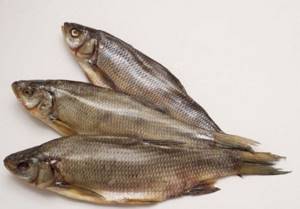
Medium-sized dried ide (and we took exactly these) takes about 2 weeks to prepare, but after the end of the first 7 days the condition of the fish should be checked, since drying and withering depend not only on salting, but also on the weather, wind strength, and air humidity. It is optimal to dry ides in a dry basement under a fan or convector. If, during the next inspection at the cut, the meat exudes a pleasant aroma and is slightly translucent, you can remove the ide for tasting. Despite the small bones, dried ide is a very tasty dish.
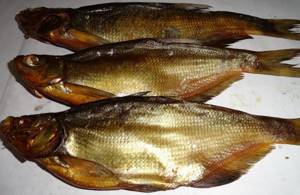
Follow us on social networks
— through them we publish a lot of interesting information, photos and videos.
Popular sections of the site:
The fisherman's calendar will allow you to understand how all the fish bite depending on the time of year and month.
The fishing gear page will tell you about many popular gear and devices for fishing.
Fishing baits - we describe in detail live, plant, artificial and unusual ones.
In the bait article you will get acquainted with the main types, as well as tactics for using them.
Learn all the fishing lures to become a real fisherman and learn how to choose the right one.
Color and other characteristics
Knowing what ide looks like, you can quickly recognize it. The body is externally thick, with a dense short head, oblique and small mouth. Depending on the habitat, time of year, and age, individuals look different. In spring, the fish almost entirely acquires a metallic sheen of silver color with a gray tint. From the gill slits to the end of the head there is a golden reflection.
A characteristic feature of the color of this fish is its play in sunlight. When the body turns towards the sun, there is a rapid change in tones from silver to almost dark gold, the fins, both upper and lower, have a red tint. The back is dark blue, almost black, the sides are whitish, and the belly is bright silver. The eyes are yellow, sometimes mixed with green. The color of adults is more intense and bright than that of young animals, which are called roaches.
How to salt ide at home: simple recipes and curing features
Ide is a freshwater river fish of the carp family. Quite common in Russia. The fish is suitable for drying and smoking, so it is a favorite beer snack. Fillet contains a lot of fat and nutrients. But in addition to its benefits, river fish can cause harm to the human body, since it often contains parasites.
Follow all the rules to protect yourself from possible opisthorchiasis. You need to know how to salt ide at home, since your health will depend on the correct implementation of all stages.
Habitat area
It has a wide distribution area:
- Most countries in Europe (except the south and southeast).
- The Arctic Ocean basin (from the White Sea rivers to the Lena).
- Bays of the Baltic Sea.
- Basin of the Aral Sea.
- The main territory of Siberia.
- Black Sea basin.
- Northern section of the Caspian basin (Volga and Ural rivers).
- North America (Connecticut in the USA).
Ide is very widespread in Ukrainian reservoirs , where it is found in almost all lakes, reservoirs and rivers.
Preparing for pickling
Ready-made fish appetizers can be purchased in the store, but you cannot be sure that fresh, clean and safe raw materials were used for preparation. Salting ide in your own kitchen, taking into account all the rules, will allow you not only to enjoy your favorite dish, but also to avoid opisthorchiasis. Some rules will help you prepare for salting correctly:
- Do not expose the frozen product to additional heating, but rather melt it under natural conditions;
- salt the fish only with coarse sea or rock salt;
- use containers that cannot oxidize;
- It is enough to wipe whole carcasses with a clean cloth;
- remove the entrails;
- to salt the fillet, be sure to remove the head, fins, tail, ridge, large bones, leaving the skin;
- The slices are washed in water and excess moisture is removed with a napkin.
Dry method
Ide is usually salted in large batches, so deep wooden boxes are used. There should be small gaps between the boards to allow excess liquid to drain. We salt the head especially well, filling the mouth and gills. Cover the bottom completely with salt and lay out the prepared whole carcasses in layers. You must remember to salt each row, including the last one. Cover and press with a press. Fish salted in this way should last for two to three weeks. After the time has passed, we wash the ides and soak them in water for several hours, changing it periodically. We hang each fish and place it in a ventilated place, under a canopy.
Quick salting
This method is quite easy and the fastest. I salted the ide for several days and you can already enjoy its delicious meaty fillet.
For 700 grams of fish meat you will need:
Mix the bulk ingredients together. Cover the slices with the mixture. Place them in a pickling container so that the sirloin part is at the bottom. Cover with a tight lid and refrigerate for 4 days. The pieces need to be turned over about twice a day. Already salted ide goes through the stage of rinsing and slight drying using a waffle towel.
Cooking Variations
Ide is baked, fried, salted, boiled, smoked, and also used to prepare filling for pies and canned food. The most popular fish dishes are fish soup and aspic, aimed at stimulating the production of gastric juice.
"Pickling ide"
Ingredients:
- sugar – 100 g;
- salt – 200 g;
- fish carcasses – 4 pcs;
- crushed allspice, coriander.
Cooking principle:
- Wash the fish, cut off the tail and head, rip open the belly, remove the entrails, and wipe with a dry cloth. If desired, you can additionally remove the ribs and spine.
- Rub the fish fillet with spices, sugar and salt.
- Place the carcasses under pressure and leave in a cool place for 2 days.
The finished fish tastes like salmon. It can be eaten raw or smoked.
Remember to take extra care when cleaning fish. At the end of gutting the carcass, wash your hands thoroughly, and pour boiling water over the cutting board and knife. Otherwise, the likelihood of infection with worms increases.
"Baking ide"
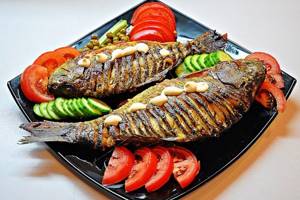
Ingredients:
- lemon juice – 30 ml;
- onions – 2 pcs;
- fish carcass – 4 pieces;
- lemon – 0.5 pcs;
- red and black pepper, salt;
- sour cream;
- vegetable oil.
Cooking principle:
- Peel the fish, cut off the fins, wash.
- To eliminate the smell of mud, place the ide in a weak salt solution for 2 hours.
- Peel and chop the onion, mix with spices and lemon juice. Stuff the carcasses from the inside with the resulting mixture.
- Make transverse cuts on the outside of the body. Insert lemon rings. Rub the ide shell with salt and pepper.
- Pour vegetable oil onto a baking sheet, place onion rings on top, lay the carcasses, coat with sour cream. Cover the pan with foil and place in a preheated oven for 1 hour, maintaining the temperature at 180 degrees. 15 minutes before the end of cooking the fish, remove the “metal” paper.
Dishes made from ide are widely popular among gourmets all over the world, as it goes well with most foods. Among which are: onions, potatoes, tomatoes, cilantro, mint, spinach, parsley, sour cream, cheese, milk, porcini mushrooms, oyster mushrooms, champignons, raisins, crabs, lemon zest.
Spices compatible with fish: sesame, thyme, nutmeg, pepper, vinegar, coriander. To emphasize the expressive taste of ide, beer, white wine, wheat flour, macemel, and olive oil are used. Serve with cream sauce.
How to cook ide
Stuff with eggs, herbs, pickle with coriander, bake with mushrooms with sour cream or sesame seeds and tomatoes, stew with raisins in beer or wine, smoke with spices. In addition, fish is used to prepare aspic, fish soup, cutlets, canned food, and fillings for pies.
Jerky "block"
The method is widely used in the Siberian region, as it involves long-term freezing. Salting with a “block” is not only to rid the ide of opisthorchiasis, but also to stock up on dried snacks for future use. For this recipe, the catch must be caught in winter or autumn, when the fish has accumulated a sufficient amount of fat and has been cleaned.
The carcasses are placed in a large barrel or other container and covered with a layer of snow, compacting it. Leave it outside until March. In the spring they gradually take out about 30 pieces. The batch is defrosted under natural conditions until half-thawed. Next, the ides are salted dry in a wooden box, but the aging period is significantly reduced. It is known how long to salt fish of various sizes. This period is 6 days for small individuals, 7 days for medium ones and 8 days for large ones. The next stage is rinsing from salt and mucus. You can use a sponge or cloth. Hang each fish by the tail or eye hole, stringing it on a wire. The drying room must be well ventilated. The process takes from 1 to 2 weeks.
Advice! You can check the fish for salinity. To do this, we lower it into a bowl of cold water and see which carcass rises to the top. If there are any, then they are considered undersalted. These specimens are dried separately.
Prevention of opisthorchiasis
The main cause of infection is under-fried, salted and dried fish. Ide, like other representatives of cyprinids, is often affected by pathogenic worms. There are simple tips for preventing opisthorchiasis:
- you should refrain from cooking in natural conditions, as many fishermen do;
- conduct a thorough inspection for the presence of parasites;
- the larvae die from exposure to boiling water in at least 15 minutes;
- freezing for 7 hours at a temperature of -40 makes the product absolutely safe;
- fry for at least 20 minutes covered;
- hot smoking destroys worms;
- salt caviar only after heat treatment;
- It is recommended to use the amount of salt at the rate of 1 to 5 and apply in multi-layers.
Advice! To completely exclude opisthorchiasis, small ides need to be salted for three weeks, and individuals larger than 25 cm - 40 days.
Representatives of the carp family are most often infected with parasites. But their availability and taste attract attention. If you properly salt ide at home, strictly following all the instructions, then pathogenic organisms can be avoided. And fish and its caviar will become a frequent addition to the table.
Fishing for ide
Sports and amateur fishermen are showing increased interest in catching ide, because this fish is large in size and contains many useful substances. You can catch this type of fish all year round. The meat of this fish is very tasty and healthy, it also contains all the vitamins and microelements, as well as protein necessary for the proper development of the whole organism.
Fishing methods
The ide is caught on various fishing rods; what to catch the ide with and with what, the person decides for himself. It also depends on the season when fishing takes place.
All fishing rods are suitable for catching ides; the most effective ones are listed below:
- fly float;
- wire fishing rod;
- Bolognese tackle;
- match fishing rod;
- donka;
- feeder;
- live bait fishing rod;
- fly fishing tackle;
- bombard;
- spinning.
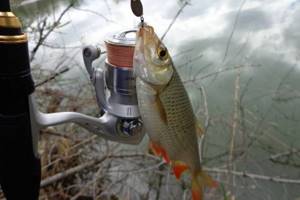
In winter, special gear is needed to catch an omnivorous semi-predator:
- nod;
- a fishing rod with a float, which must be kept exclusively under water at all times so that the float does not freeze to the ice.
It is impossible to say when the season for catching fish such as ide opens, because it can be caught in any season (avoiding only the spawning period). It may not bite only in severe frosts, but with minimal warming it immediately begins to please the fisherman with an active bite.
The highest feeding activity occurs 5 days after the end of spawning and when autumn cold snaps begin. But in the autumn the zhor is somewhat weaker than at the end of spawning, but lasts for as long as 3 weeks.
Baits and lures
The mouth of this type of fish is small, therefore the baits should be small from number 0 to 2, and the length of the spoon does not exceed 4 cm. As for the hooks, their size should be a maximum of 5. The ide is a shy and cautious fish, so you need to fish silently , and it is advisable to disguise yourself. For the tackle, a transparent fishing line is suitable, the diameter of which should be 0.22 mm, and the leashes should be 0.18 mm.
If fishing is done using a float, the following baits are used:
- grasshopper;
- caddisfly;
- muckworm;
- maggot;
- dragonfly;
- mole cricket;
- Chafer;
- bark beetle;
- mayfly;
- reed shoots;
- fry;
- wobblers;
- jig with a piece of fish;
- peas;
- dough;
- semolina;
- insect larvae;
- worms;
- bloodworm.
Plant-based baits can also be used to catch ide: dried canned peas, corn, semolina, bread, etc.
To catch ides, you can use a simple bait, but always with a scent:
- vanilla;
- sunflower oil;
- birch branches.
This bait can be made at home from bread with the addition of clay. The bite is confident and at the same time fast, so the fisherman should always be on the hook. Fishing with a spinning rod is quite effective.
As for vegetation, the best recommended algae is mulberry, especially when fishing for wiring. Starting from the month of May, this bait performs better than anyone else in its fishing, and not only on ide, but also on:
- rudd;
- roach;
- ruff;
- crucian carp
For bait, shoots no longer than 10 cm are suitable; a strand of algae is woven around the hook and tied, leaving a little strand to hang down.
Such algae can be found on stones at a depth of 30 cm, as well as on driftwood and concrete structures (bridges, piers, slipways).
For bottom gear they use live bait from small fish: dace, bleak, gudgeon and small toads. The ide is a picky fish, it picks at its food, but it never refuses bark beetles (larvae) and dragonflies.
In the video below, a fisherman catches an ide with a homemade spoon and tells how you can catch fish, with what and in what places:
The ide seems lazy and slow-moving, but when free it offers stronger resistance than many other fish. As soon as the ide is hooked, it begins to wriggle, wriggle, and jumps out of the water. Often he manages to get rid of bondage by cutting the fishing line with his sharp fin.
How to cook ide fish
Before you cook ide deliciously, you should free it from scales, entrails and, if possible, bones. Besides:
- Cook over low heat so as not to dry out the fish.
- The specific aroma disappears during cooking; it is better to bake it on the grill, in the oven, or simmer in a small amount of broth or sauce.
- Do not overcook the pieces - they will absorb a lot of oil and become tasteless.
- Fish goes well with sour fruit and berry sauces and side dishes of fresh or boiled vegetables.
- To ensure that the pieces are juicy on the inside and crispy on the outside, they should be breaded, first dipped in melange.
- Ides are also delicious in salted, dried, and smoked form.
Ide baked in the oven

You can cook ide in the oven whole or in large pieces. To do this, in addition to fish, you need to prepare:
- onions – 2 pcs.;
- vegetable oil – 30-50 ml;
- sour cream – 100 g;
- lemon – 1 pc.;
- salt, pepper.
First, transverse cuts are made on the fish, freed from scales and giblets, and rubbed with a mixture of pepper and salt. Then rub the baking sheet with vegetable oil and lay out the onion rings. Half circles of lemon are inserted into the cuts, the carcass is coated with sour cream and placed on an onion bed.
If prepared in pieces, then parts of the lemon are placed inside each piece. The ide is cooked in the oven for 40-60 minutes whole and 30-40 minutes in pieces at a temperature of 180 degrees.
In the same way, you can cook ide in the oven with potatoes. To do this, boil the potatoes until half cooked in salted water, then cut them into 1 cm circles and cover them with whole fish or large pieces. In this case, replace the sour cream with mayonnaise and grease the potatoes with it.
Another very interesting recipe is baking in a shell from a mixture of coarse and fine salt (2:1), egg whites and a small amount of water.
Fish value
Ide has an excellent taste of meat, so it is very popular in cooking. There is only one drawback - it is excessive bonyness, which can be eliminated using several methods:
- Marinate the fish for a long time in a vinegar solution for 24 hours.
- The meat is passed through a meat grinder and cutlets or meatballs are formed.
- Making canned food in vegetable oil, in which case the fish is stewed for a long time until the bones are completely softened.
Ide meat has a color ranging from white to yellowish. A wide variety of dishes are prepared from ide; it can be:
- stew;
- cook;
- fry;
- bake;
- pickle;
- marinate;
- dry;
- dry;
- preserve;
- make filling for pies.
Ide cannot be stored unprocessed for a long time, since the meat quickly deteriorates and its taste deteriorates. After fishing, it is advisable to immediately clean and gut the fish. Raw meat can be stored in the refrigerator for no longer than a day.
Nutritional value per 100 grams of product is indicated in the table.
| The nutritional value | Gram |
| calorie content | 117 |
| squirrels | 19,0 |
| fats | 4,5 |
| water | 75,4 |
| ash | 4,1 |
Fish meat contains many vitamins, micro and macroelements, protein, and fatty acids necessary for humans. The ide protein contains the following amino acids:
- taurine;
- lysine;
- tryptophan;
- methionine
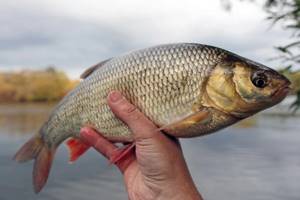
Ide has a low calorie content, so even nutritionists value the meat and include it in the menu of many diets. In addition, there are additional useful properties:
- The presence of high amounts of fluoride and calcium, which strengthen bones, hair, teeth, and also prevents problems of the musculoskeletal system.
- Extractive substances have choleretic properties, so they stimulate the digestive tract, improve appetite and prevent gastrointestinal problems.
- Many vitamins strengthen human organs and the immune system.
- Since meat contains plenty of vitamin B, regular consumption will reduce nervous tension, aggressiveness and overexcitement.
- Nutrients normalize blood circulation, reduce cholesterol levels, increase vascular tone and prevent Parkinson's disease.
Fried ide with sour cream and onions
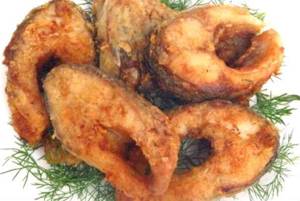
Fried ide in a frying pan is especially tasty with onions and sour cream. To prepare it, in addition to fish, you will need to prepare:
- sour cream - 4 tbsp. l.;
- breadcrumbs - 4 tbsp. l.;
- onions – 1 pc.;
- salt - to taste;
- vegetable oil – 4 tbsp. l.
Before frying the ide, it should be freed from scales, entrails, fins, head and tail. Then rinse, dry with napkins and cut into portions. After that, salt them, roll in breadcrumbs and fry on both sides in a frying pan with heated oil.
The finished fried ide should be set aside, the onion half rings should be simmered in the remaining oil and the finished fish should be placed on top for 5 minutes, without reducing the heat. At the end add sour cream, mix and serve on lettuce leaves.
Fried ide with onions and sour cream
Ide fried in sour cream sauce is a traditional delicacy for Russian cuisine. Sour cream sauce will add tenderness to the pulp and make the meat richer and more tasty. Necessary components of the composition: ide meat - 1.3 kg, a couple of onions, ½ cup of sour cream, a glass of breadcrumbs, ½ cup of clarified butter, 3-5 tbsp. l. lemon juice, 1 tsp. crushed salt and freshly ground pepper.
Recipe for fried fish with sour cream. Clean the carcass from entrails and scales, wash and dry with a napkin. Soak the fish in salt water for 2 hours, remove from the liquid and wash again. Cut the ide into pieces no more than 4 cm wide. Salt the slices, sprinkle with pepper and roll in breading. Place fish pieces in oil and fry for 12 minutes until nicely crispy.
Place the onion cut into half rings over the ide and continue frying for another 4 minutes. Pour the sour cream evenly, cover the frying pan with a lid and simmer for 3 minutes. Keep the finished dish covered for 5 minutes and serve it to the table with herbs, lemon slices and sliced tomatoes.
How to salt ide correctly
You can pickle ide at home in different ways - dry, quick or in brine. In any case, you should adhere to some requirements:
- The carcass must be fresh or chilled.
- Before salting it must be gutted.
- The salt used is not iodized.
- The container is clean and dry.
- It is better to take enamel or glass containers.
Dry method of salting ide
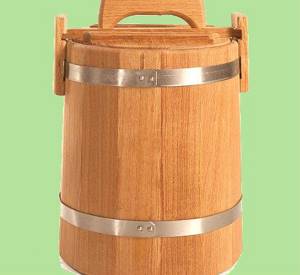
For 5 kg of fish you will need to prepare:
- sugar – 50 g;
- peppercorns – 10 g;
- coarse salt.
Fine salt can burn and oversalt the fish, but it does not dehydrate, which is necessary for the dense consistency of the finished product.
You should salt the ide as follows:
- Gutted fish is coated with a mixture of salt and sugar inside and out and placed in a container, sprinkled with pepper.
- The last layer is salt and sugar.
- Place a lid and pressure on top (a jar of water will do).
- Then the container is placed in a cool place for 3-4 days.
A quick way to pickle ide
For this method, for every 700 g you will need 1 tbsp. l. sugar and 2 tbsp. l. salt. Gutted fish are first freed from the head, tail and fins. Cut lengthwise into two parts and then into pieces 5 cm in diameter. Then they are placed in a container, layered with a mixture of salt and sugar. After 2-3 days, the salted product is ready.
Another quick way, the so-called salmon one, is as follows:
- First, they fillet it, removing large bones if possible.
- Then the pulp is slightly dried with a towel.
- Place fillet pieces into a container or jar, sprinkling them with a sugar-salt mixture (1:2) in an even thin layer.
After 1-2 days, the fish can be served with boiled hot potatoes.
In addition, ide can also be salted in brine, which is prepared from 2 liters of water, 500 g of salt, black pepper and bay leaf (for 3 kg of fish). All spices should be boiled in water, the brine should be cooled and small pieces of fish or fillet should be poured over them.
The fish will be ready in a week.
In addition, you can pickle ide caviar. To do this, you will need a strong brine - a strong brine in which an egg or potato will not sink.
Important! For 100 g of caviar, take about 120 g of salt. The volume of brine should exceed the volume of caviar by 3 times.
The brine should first be boiled for 10 minutes, cooled to 40 degrees and caviar placed in it. For 15 minutes, carefully stir the mass so that it is well saturated with salt and place on a sieve to remove liquid. A little vegetable oil is added to the salted caviar.
How to properly prepare ide for pickling?
Thaw frozen fish first (at room temperature or in the refrigerator). After this, if you salt whole carcasses, simply wipe them with dry towels or paper napkins. If you plan to cook fillet, first peel the fish. Then gut the belly. After this, rinse the carcass. Dry it. Now cut off the head, tail and remove the fins. Then, using a sharp knife, carefully separate the fillet from the spine, leaving the skin on. Dry again.
How to salt ide correctly?
There are two main ways to pickle ide. Let's look at both. So.
Dry method of salting ide
You will need a wooden box. The boards on the bottom and sides should fit loosely against each other so that liquid can flow out. Immediately place the container in a cool place (ideal temperature for pickling is +3 to +5 degrees). Sprinkle salt (coarse or medium) evenly onto the bottom. Now spread the ide in one layer. Next, sprinkle generously with salt. Don't forget to fill your mouth and gills with it. And again fish. So almost to the very top. Sprinkle salt generously and evenly on top. Apply heavy pressure. Salt the ide for 2-3 weeks. Then wash it and soak it in cold water for several hours (it is better to change the liquid 3-4 times). And hang it to dry in the shade in a draft.
A quick way to pickle ide
Take prepared ide fillet (0.7 kg). Sprinkle it on the meat side with 2 tablespoons of coarse sea salt, and on top with 1 tablespoon of sugar. Try to do this as evenly as possible. If you use regular rock salt, you can immediately mix it with sugar 2:1 and season the fish.
After this, fold the fillets skin side up and place them in a glass or plastic container. Cover with a lid or cover with cling film and refrigerate for at least 3-4 days. It is advisable to turn the ide over 1-2 times a day. Then take it out, rinse lightly under cold water and dry.
Of course, you can add any chopped spices and fresh herbs to the pickling mixture, but do this carefully so as not to clog the taste of the ide.
Drying with a block

The process is a type of cold drying, it gives the fish elastic properties. To get dried ide, you must first salt it.
The fish taken is medium-sized - 20 cm long in a batch of 18-20 pieces. For salting you will need the following:
- a box with holes in the walls;
- polyethylene;
- oppression;
- salt – 3 kg;
- laurel – 7 pcs.
First, the carcasses are gutted, washed, rubbed with salt from the inside and placed in a box on a 1-2 cm layer of salt. Each soy of fish is sprinkled with salt and bay leaf. The top is covered with polyethylene and oppression is installed. The entire structure is placed on a tray for the released liquid and taken out to a cool place.
After 5 days, the ides are taken out and placed in cold water, using a large container, such as a bathtub, for 2–3 hours so that the fish gives up excess salt. After the specified time, the ides are laid out on newspapers to dry.
Then the fish are hung by their tails on copper or aluminum hooks and sent to dry in the fresh air, after being coated with vegetable oil. This way flies won't land on them.
Advice! You can dry fish in the basement using a fan or convector.
After 2 weeks, the ide will dry and be ready to eat.
How to smoke ide
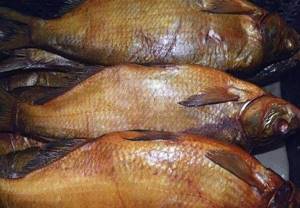
In order for the ide to be cold smoked, it will take a lot of time and the arrangement of a smokehouse, consisting of a container for fish, connected by a pipe to a metal firebox-hearth, where the fire will burn.
First, the ide should be salted in any way for 3 days. After which it is dried for another day. Then it is hung in the smokehouse on hooks by its tail. Light a fire and smoke for the first 12 hours without breaks. Then you can stop the process (at night) and resume it periodically for another 2-3 days for 12-14 hours.
On a note! Smoked ide should be ventilated for 24 hours.
Hot smoked fish cooks very quickly. To do this, ide (2 kg) is gutted, washed, rubbed inside and outside with salt (50 g). After 2–3 hours, wipe with a napkin, spread with vegetable oil, and insert a wooden spacer into the upper part of the abdomen.
A couple of handfuls of hardwood chips are poured into the bottom of the smokehouse, a grate is installed, on which the ide is placed. Then the smokehouse is closed and put on fire. After 40 minutes, the product is ready for use.
Prevention of opisthorchiasis
Opisthorchiasis is a disease of the liver, gallbladder and pancreas caused by flatworms - small parasites 10-15 mm long and 1-2 mm wide, flat-shaped. Infection occurs when eating insufficiently disinfected fish. Treatment is carried out on an outpatient basis.
For preventive purposes, fish should be consumed well-salted, fried or boiled. Avoid planed, chopped, and lightly salted fish.
When freezing, certain regimes must be followed. Temperature in the fish carcass and the required minimum time in hours:
- 40 degrees 7 hours
- 35 degrees 14 hours
- 28 degrees 32 hours
- In a household freezer - at least a month.
Considering all that has been said, we can conclude that the preparation of fish dishes should be treated with full responsibility, including dishes made from ide.
Useful properties of ide
Freshwater fish - representatives of cyprinids, which include carp, bream, tench, roach, crucian carp, carp, asp, ide and silver carp - have long been highly valued as a source of complete protein and vitamins.
Ode meat contains 117 kcal, rich in protein, potassium, phosphorus, also contains calcium, magnesium, sodium, chlorine, iron, fluorine, chromium, molybdenum, nickel, as well as vitamin PP, etc.
Ide is very easily and quickly digestible. Boiled or baked, it is an indispensable product for dietary nutrition. Fish is especially useful for heart diseases, as well as gastritis and gastric ulcers.
One of the main values of Ide is protein with a unique ratio of essential amino acids. The most valuable of them are tryptophan, lysine, methionine and taurine.
Ide meat contains very important minerals: calcium and phosphorus. Its regular use protects against osteoporosis and strengthens teeth and bones.
Ukha and freshwater fish aspic are excellent dishes to stimulate digestion. The extractives in the broth increase the secretion of gastric juice and pancreatic enzymes. Therefore, both ukha and aspic are useful for gastritis with low acidity.
Dangerous properties of ide
Salted and dried river fish are contraindicated for hypertensive patients and patients with severe kidney disease.
Ide bonefish, accidentally swallowing a fish bone can cause intestinal damage.
The beneficial and dangerous properties of ide depend on the cleanliness of the reservoir in which it was caught.
That's how much positivity a Yayayaz caught with one's own hands can bring! The video shows a successful fisherman genuinely happy about the fish he caught. This video has currently received more than 7 million views on YouTube, and its author, Viktor Nikolaevich Goncharenko, has become a living legend of the Internet.
Tatyana Eliseeva chief editor of the Food+ project
Ask a Question
Rating:
0
/10
Votes: 0
Material usefulness 0
Reliability of information 0
Article design 0
